
Aoraia is a genus of moths of the family Hepialidae. There are 13 described species, all endemic to New Zealand. The type species of this genus is Porina dinodes Meyrick, 1890. This genus contains some large species with a wingspan of up to 150 mm.

Heloxycanus patricki, also known as the sphagnum porina moth, is a species of moth of the family Hepialidae, the ghost moths. It is the only member of the genus Heloxycanus. This species is endemic to New Zealand. It has been classified as having the status of "At Risk, Declining" by the Department of Conservation.

Stigmella progama is a species of moth in the family Nepticulidae. This species is endemic to New Zealand. It is classified as "Data Deficient" by the Department of Conservation. S. progama has only been collected on Bold Peak in Otago.
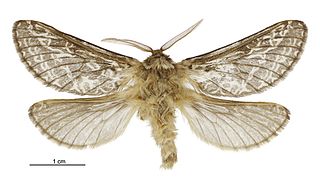
Aoraia aspina is a species of moth of the family Hepialidae. It was described by John S. Dugdale in 1994 from specimens collected in the Tasman, Otago and Southland districts. It is endemic to New Zealand.
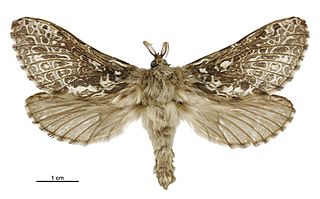
Aoraia aurimaculata is a species of moth of the family Hepialidae. It was described by Alfred Philpott in 1914 from a specimen collected at The Hermitage, Mount Cook by F. S. Oliver. This holotype specimen is now lost. A. aurimaculata is endemic to New Zealand,

Aoraia dinodes is a species of moth of the family Hepialidae. It is endemic to New Zealand. This moth was described by Edward Meyrick in 1890 from specimens collected in Invercargill by Captain Hutton.

Aoraia enysii, also known as the forest ghost moth is a species of moth of the family Hepialidae. It is endemic to New Zealand. This is the only species of the genus Aoraia that can be found in the North as well as the South Island. This species can be found from Mount Te Aroha southwards. This species was described by Arthur Gardiner Butler in 1877 from a specimen obtained in the North Island by J. D. Enys.

Aoraia flavida is a species of moth from the family Hepialidae. It is endemic to New Zealand. This species was described by John S. Dugdale in 1994 from specimens obtained near Gem Lake in the Umbrella Mountains in Southland and collected by B. H. Patrick.
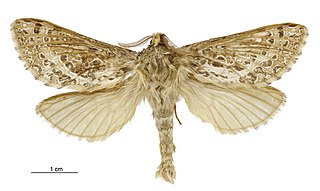
Aoraia insularis, also known as the Rakiura ghost moth, is a species of moth of the family Hepialidae. It is endemic to New Zealand and is found on only on Stewart Island and Steward Island's surrounding smaller islands. It was described by John S. Dugdale in 1994.

Aoraia lenis is a species of moth of the family Hepialidae. It is endemic to New Zealand. It was described by John S. Dugdale in 1994.

Aoraia oreobolae is a species of moth in the family Hepialidae. This species is endemic to New Zealand. It is classified as "At Risk, Naturally Uncommon" by the Department of Conservation.
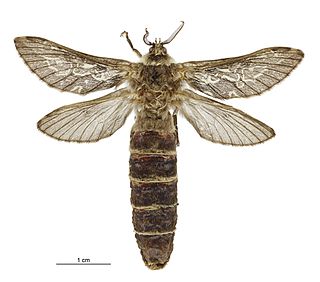
Aoraia orientalis is a species of moth of the family Hepialidae. It is endemic to New Zealand and is found in eastern Central Otago. It was described by John S. Dugdale in 1994.

Aoraia rufivena, also known as the rufous-veined aoraia or the Otago ghost moth, is a species of moth of the family Hepialidae. It is endemic to New Zealand. A. rufivena was described by John S. Dugdale in 1994.

Aoraia senex is a species of moth of the family Hepialidae. It is endemic to New Zealand, where it is known from the South Island. This species was first described by George Vernon Hudson in 1908 from specimens discovered by J. H. Lewis in Central Otago.

Dioxycanus fusca is a species of moth of the family Hepialidae. It is endemic to New Zealand. This species was first described by Alfred Philpott in 1914 as Porina fusca using specimens collected by C. Fenwick and M. O. Pasco. In 1966 L. J. Dumbleton reviewed New Zealand Hepialinae and placed this species within the genus Dioxycanus, giving it the new combination Dioxycanus fuscus.

Dioxycanus oreas is a species of moth of the family Hepialidae. It is endemic to New Zealand. It was first described by George Vernon Hudson in 1920. The species was discovered by Averil Lysaght.

Dumbletonius characterifer is a species of moth of the family Hepialidae. It is endemic to New Zealand. It was first described by Francis Walker in 1865.

Dumbletonius unimaculatus, also known as the forest ghost moth, is a species of moth of the family Hepialidae. It is endemic to New Zealand. This species is host to the vegetable caterpillar fungus Ophiocordyceps robertsii.
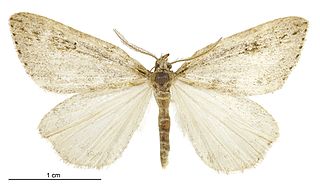
Pseudocoremia cineracia is a species of moth in the family Geometridae. It is endemic to New Zealand. It is classified as Nationally Vulnerable by the Department of Conservation.
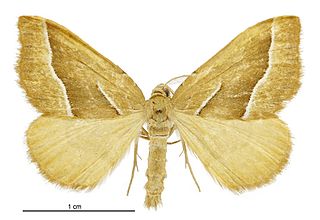
Asaphodes stinaria is a moth in the family Geometridae. It is endemic to New Zealand and has previously been observed in both the North and South Islands. The range of this species has contracted and it has recently only been located in Westland, Otago and Southland. This species inhabits wetlands, tussock country, and in grassy openings in native forest. The larval host species has been hypothesised as being 'hairy' Ranunculus species however as at 2000 this hasn't been confirmed. It is classified as Nationally Vulnerable by the Department of Conservation. There has been considerable reductions of the range of this species with it possibly becoming extinct in eastern parts of New Zealand.



















